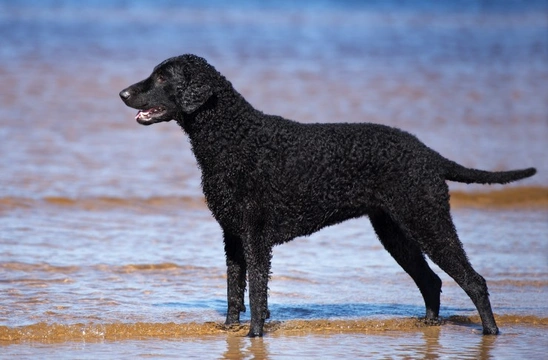
5 personality traits of the curly coated retriever
The curly coated retriever is one of the oldest known retriever breeds, and like their relatives the Labrador and the Golden retriever, they were initially bred and trained largely for working-retrieving roles, and less commonly, as pets.
Today, as many of the traditional working roles that required retrieving dogs have been eroded, the curly coated retriever is more commonly found as a pet, and while they may not be as common or popular as some of the better-known retriever breeds, there is a lot to be said for them if you are in the market for a new dog from the medium-sized, reasonably energetic options.
If you are considering buying or adopting a curly coated retriever, this article will help to provide a short primer on some of the breed’s core traits, benefits and challenges, to use in combination with the rest of your research when making a decision. Read on to learn more!
1. They love to swim
Like many of the retriever breeds, the curly coated retriever is a real water baby, and in their working roles, they would often spend all day out and about covered in mud and goo, retrieving downed birds on both land and water.
As natural swimmers, it is nice to allow dogs of the breed to do their thing from time to time, and if you live near to a suitable swimming lake or pond, all the better. However, curly coated retrievers usually need no encouragement to go swimming, and so it is important to train them to ensure that they do not simply leap into any available water source when you don’t want them to!
2. They are very energetic
All of the retriever breeds tend to be fairly high energy, and this is certainly true of the curly coated variant! Whilst they do not quite fall into the very highest bracket in terms of exercise requirements (which includes the most high-energy breeds like the Border collie and Siberian husky) they are certainly in the next bracket down!
If you lead the type of lifestyle that involves a lot of time spent outside and taking your dog with you, and you enjoy walking, rambling or jogging, the curly coated retriever may be a good match.
However, if you are not prepared to dedicate a bare minimum of an hour or two a day walking your dog and interacting with them in some form of physical activity, your dog is likely to become bored and unhappy.
3. They are normally a pleasure to train
The curly coated retriever falls pretty much right in the middle of the pack in terms of canine intelligence by breed, which means that they are usually reasonably easy to train. Whilst it might seem that the brighter a breed is, the more trainable they will be, in some cases the opposite is true, and it requires an experienced, adaptable trainer to be able to work with a very smart dog.
Most dog training manuals and guides too are aimed at training dogs in the middle of the pack, and so are designed to suit the skills and learning pace of such breeds-which means that training a curly coated retriever is usually fairly straightforward, and they usually try hard to please you, and enjoy the whole process.
4. They are very food-oriented
Retriever breeds really corner the market when it comes to dogs that are obsessed with food, and the curly coated retriever is a classic example of this! This trait means that using training treats will help your dog to learn quickly and keep them trying hard to please you.
However, because this breed can and will eat anything they can get hold of, it is important to carefully monitor their food intake and keep them at a healthy weight, and ensure that they don’t scavenge from the bins or pick up scraps out and about when walking.
5. They can be a little clumsy
The curly coated retriever is a relatively tall, medium sized breed, and while they are not particularly bulky, the fact that they are almost constantly in motion and usually propelled by a frantically wagging tail can make them rather clumsy!
They don’t know their strength or size, and whilst they are highly unlikely to be overly pushy or dominant, their size, strength and enthusiasm about everything means that you will have to keep an eye on them to ensure that they don’t knock over a child or smaller dog, nor sweep all of your cups off the coffee table with their tails!
This breed trait can be rather endearing to their owners, and the curly coated retriever was born for the role of clown-but teaching the dog good manners when it comes to not jumping up at people or being too boisterous is important too.



